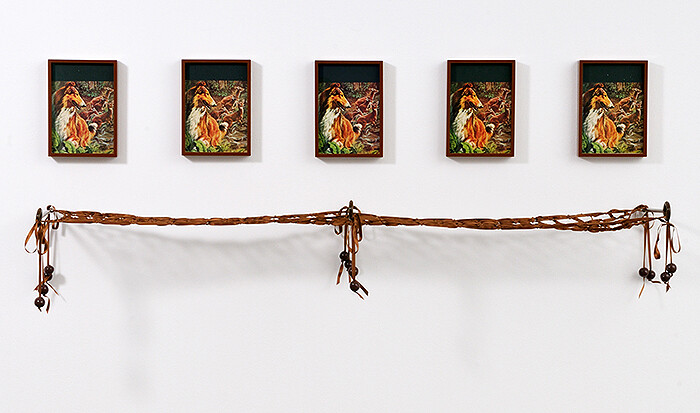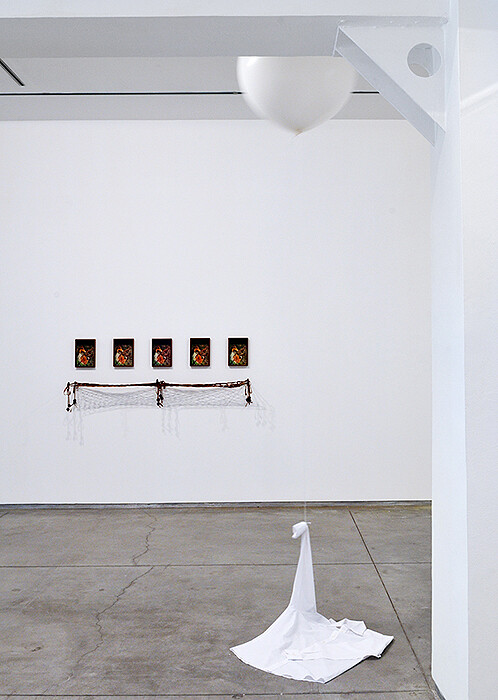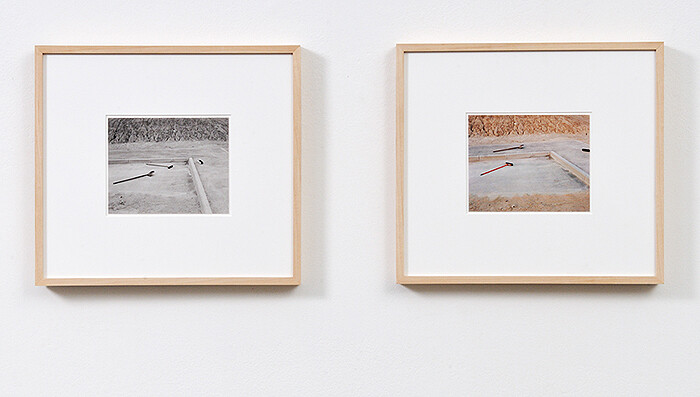Apparitions, classified as celestial and flighty phenomena, spawn earthly suppositions from their beholder. And these thoughts can be utterly profane: Are Lassie and Bambi checking each other out, as Elad Lassry’s Collie (Deer) (2013) ensemble suggests? Wasn’t Bambi a minor? Wasn’t Lassie gay? What gender was Bambi supposed to be in the first place? Such are the less profound questions this multifaceted summer group show elicits, which in Lassry’s case hark back to the cherished wildlife from western pop culture. To this extent, both deer and collies are fully deserving of the same iconic lionization that their two-legged counterparts have enjoyed, like Marilyn Monroe or Elvis Presley, and subsequent Andy Warhol-worthy stars like Debbie Harry. As if transformed hands-on by Ikea’s creative team into something that resembles a wall-mounted, cassette-tape rack, Harry’s visage in Gregor Hildebrandt’s KSK Blondie (2014) materializes as neo-Pop-halftone-raster art.
Returning to Lassry’s typically sleek coated identity politics of just about everything—including what might be conspicuously bulbous Christmas decorations and an inconspicuous wave pattern in girlish, strawberry colored tones—one also passes by Alicja Kwade’s delicately quiet, golden watch hands. Stretching across four different iterations from a mere 12 hours, passing through 24 hours, then 48 hours until three entire days in 72 hours (all 2014), these minute markers are tightly stacked, straightening out our circadian rhythm in textbook Conceptualist fashion. In this, the works delineate a nostalgic desire to gauge that fourth dimension so inexorably oblivious to our accelerationist condition. Meanwhile, Roman Signer’s Hemd (Shirt) (1995), lying quiescently tethered to a balloon, may serve as a more recent and whimsical monument to white-collar walkout. At the very least, the sculpture represents an uplifting call to arms to kick back and relax.
Elsewhere, Michal Helfman’s video, % (2013), captures a quintet of male and female dancers performing in front of tidy rows of empty, frog-green stadium seats. Choreographed to some elaborate algorithm, their formations blend dance theatre’s mundane-to-expressionistic movements with upbeat chorus line moves accompanied by a fittingly croaky soundtrack. If the work’s title implies that these entertaining structures are subject to an economic base, the piece leaves that connection unaddressed (unless you yourself walk away from it pondering the confluence of neo-avant-garde, post-Fordist, and Occupy-Wall-Street notions of performativity).
In Uri Aran’s video, Untitled (2013), the dance theme resumes, albeit through a more clearly hetero-normative lens by way of amateur, possibly parental, footage of a schoolgirls’ ballet matinee with brightly colored tutus and all. The protagonist, however, is a guy in his early 30s whose on-camera musings are difficult to follow; this is not only due to the muffled audio recording, but also to the loud, elegiac piano chords that drown out his speech even further. In spite of this, central themes of the monologue do emerge—namely, Freudian evolutionary stages, from the child’s grappling with body-object boundaries, to its social domestication, and finally, its burgeoning drives, which the Cartesian mind-body split is supposed to contain. As if to flout this psychoanalytical account, appealingly abstract images start to encroach upon the screen and resurface in the exhibition again as framed prints on the gallery’s walls.
A longer section of the video lingers on a crew of early-teenage boys riding BMX-bikes in an inner-city bike park, possibly located in New York City. Watching this piece here in Israel, the boys’ squad-like gathering, equipped with flashy crash helmets, exudes a techno-militaristic vibe, as if prefiguring the next generation of soldiers. In this, it evokes a recent dispute over the concurrent, ill-placed local iteration of Creative Times’s traveling “Living as Form (The Nomadic Version)” exhibition, which opened this spring at Technion – Israel Institute of Technology in Haifa. The university develops military equipment like the stealth drones currently being deployed in the occupied Palestinian territories. Talk about apparitions.
With Sharon Ya’ari’s unassuming pair of photographs picturing basic household equipment, like a broom and a shovel, strewn across a modest-sized lot, this exhibition finally touches on local ground. Both titled Yeruham (2008), they refer to the eponymous, out-of-the-way parish in Israel’s Negev desert. At the time these pictures were taken—one in color, the other in black-and-white—Yeruham experienced an economic upswing due to increased demand for affordable housing when the global mortgage crisis and the ensuing financial meltdown struck.
In a contemporaneous newspaper article addressing this real estate mirage, Amram Mitzna, Yeruham’s then mayor, succinctly identified the underlying force responsible for his town’s miraculous turnaround as simply being “a matter of image.”(1) Most recently though, the area’s surge in building projects has been largely tied to the government’s plan to develop army bases there. Absent, however, in an exhibition focusing on visions is the specter of the contemporary surveillance state, its apparatuses imperceptibly monitoring our communication and hovering above our heads.
1) Yanir Yagna, “Yeruham, the boomtown of the South,” Haaretz (May 14, 2009), www.haaretz.com/print-edition/news/yeruham-the-boomtown-of-the-south-1.275989.









